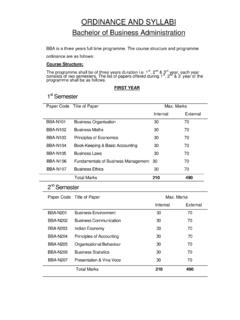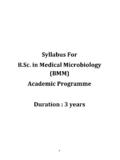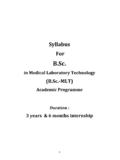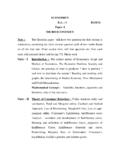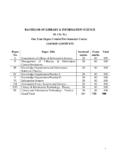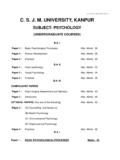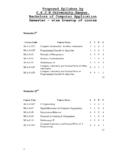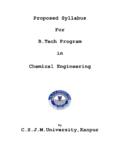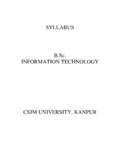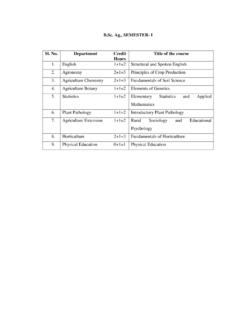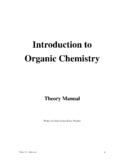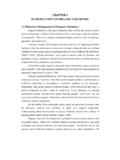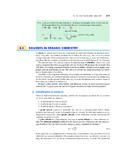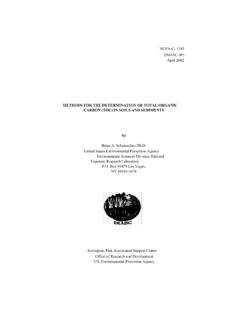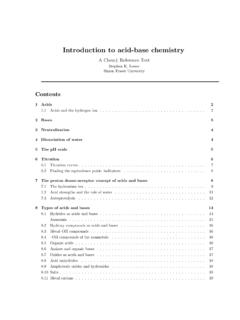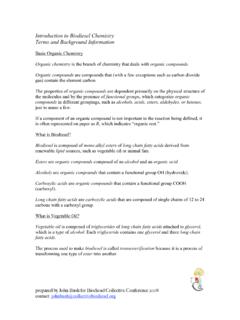Transcription of Industrial Chemistry - Chhatrapati Shahu Ji Maharaj University
1 Syllabus for I, II, III. Subject: Industrial Chemistry First Year Industrial Chemistry Paper Title of Paper Paper I - Industrial Aspects of organic and Inorganic Chemistry . 33. Paper II - Industrial Aspects of Physical Chemistry , Material and Energy balances. 33. Paper III Unit operations, Utilities, Fluid Flow and Heat Transport in Chemical Industry. 34. Paper IV Practical. 50. Second Year Industrial Chemistry Paper I Material science and Industrial Pollution. 33. Paper II Unit Processes in organic Chemicals Manufacture. 33. Paper III - Effluent treatment, Waste management and Process instrumentation. 34. Paper IV Practical. 50. Third Year Industrial Chemistry COMPULSORY PAPERS. Paper I Industrial Chemical Analysis. 40. Paper IV Chemical Process Economics and Entrepreneurship.
2 30. Paper V Practical**. 75. SELECTIVE/OPTIONAL PAPERS*. 1. Polymers 40. 2. Pharmaceuticals 40. 3. Heavy and Fine Chemicals 40. NOTES: - (i) *Select any TWO papers out of three. These two papers will be IInd and IIIrd paper respectively. (ii) ** The Factory visit of students of IIIrd Year is not compulsory for practical examination. First Year Industrial Chemistry Paper I - Industrial Aspects of organic and Inorganic Chemistry . 1. Nomenclature: Generic names, Trade names 2. Raw materials for organic compounds: Petroleum, Natural gas, Fractionation of crude oil, cracking, reforming, hydro forming and Isomerisation. 3. Coal: Types of coal, properties, calorific value, distillation of coal, chemicals derived from them. 4. Renewable Natural resources: Cellulose, Starch: - properties, modification, important Industrial chemicals derived from them.
3 Alcohols, oxalic acid and Furfural. 5. Basic Metallurgical operations: pulverization, calcinations, roasting, refining of metals. 6. Physicochemical principles of Extraction of: Iron, Copper, Lead, Silver, Sodium, Aluminium and Zinc. 7. Inorganic Materials of Industrial Importance: Availability, forms, structure and modifications of alumina, silicates, clays, mica, carbon, zeolites. First Year Industrial Chemistry Paper II - Industrial Aspects of Physical Chemistry and Material & Energy balances. 1. Surface Chemistry and Interfacial phenomena: Adsorption isotherm, Sols, Gels, Emulsions, Micro emulsions, Micelles, Aerosols, Effect of surfactants, Hydrotropes. 2. Catalysis: Introduction, Types, Basic principles, mechanisms, factors affecting the performance, introduction to phase transfer catalysis, Enzymes catalyzed reactions- rate model, industrially important reactions.
4 3. Dimensions and Units: Basic chemical calculations atomic weight, molecular weight, equivalent weight, Mole concept, composition of liquid and gaseous mixtures. 4. Material Balance without chemical reactions: Flow diagram for material balance, simple material balance with or without recycle or bypass for chemical engineering operations such as distillation, absorption, crystallization, evaporation, extraction etc. 5. Material Balance involving chemical reactions: concept of limiting reactant, conversion, yield, selectivity, and liquid phase reaction, gas phase reaction with or without recycle or bypass. 6. Energy Balance: Heat capacity of pure gases and gaseous mixtures at constant pressures, sensible heat changes in liquids, Enthalpy changes.
5 First Year Industrial Chemistry Paper III Unit operations, Utilities, Fluid Flow and Heat Transport in Chemical Industry. 1. Distillation: Introduction, batch and continuous distillation, separation of azeotropes, plate columns and packed columns. 2. Absorption: Introduction, equipments, packed columns, spray columns, bubble columns, mechanically agitated contactors. 3. Evaporation: Introduction, equipments, short tube evaporator, forced circulation evaporators, falling film evaporators, wiped (agitated) film evaporators. 4. Filtration: Introduction, equipments, plate and frame filter press, Nutch filter, rotary drum filter, sparkler filter, candle filter, Bag filter. 5. Drying: Introduction, free moisture, bound moisture, drying curve, equipments - tray dryer, rotary dryer, flash dryer, fluid bed dryer, drum dryer, spray dryer.
6 6. Utilities in Industry: Fuel: Types of fuels advantages and disadvantages. Boilers: Types of boilers and their functioning. Water: Specifications for Industrial use, various water treatments. Steam: Generation and use. Air: Specifications for Industrial use, processing of air. 7. Fluid Flow: Fans, Blowers, Compressors, vacuum pumps, Ejectors. Pumps: Reciprocating pumps, Gear pumps, Centrifugal pumps. 8. Heat Transfer: Heat exchangers- shell and tube type, finned tube heat exchangers, plate heat exchangers, refrigeration cycles. First Year Industrial Chemistry Practical: 1. Preparation of standard solution of K2Cr2O7. To find out the concentration of unknown K2Cr2O7 solution using Na2S2O3 solution as an intermediate. 2. Preparation of standard solution of copper sulphate.
7 To find out the concentration of unknown copper sulphate solution using Na2S2O3 solution as an intermediate. 3. Preparation of standardKMnO4 and ferrous ammonium sulphate solution. To find out the strength of unknown ferrous ammonium sulphate solution using as an intermediate. 4. Viscosity of liquids: Determination of relative viscosity of a liquid with water. Determination of % composition of an unknown solution. 5. Surface Tension of liquids: Determination of the surface tension of an organic liquid. Determination of % composition of an unknown mixture. 6. Polari-meter: Determination of the specific rotation of sucrose solution. 7. Refractometer: Determination of Refractive Index of a liquid by Abbe's refractometer. Determination of Molar refractivity and specific refractivity of a liquid by using Abbe's refractometer.
8 8. To find out the melting points of organic compounds. 9. To find out the boiling points of organic compounds. 10. To find out the partition coefficient of . Iodine between CCl4 and water Acetic acid between water and benzene. 11. Chromatography: To separate and identify the amino acids by ascending paper chromatography. To separate and identify the sugars by ascending paper chromatography. 12. Separation of a mixture of dyes by column chromatography. 13. Preparation of Aspirin. Second Year Industrial Chemistry Paper I Material Science and Industrial Pollution. 1. Mechanical properties of materials and change with respect to temperature. 2. Metals and alloys: Important metals and Alloys, Iron, Copper, Alluminium, Lead, Nickel, Titanium and their alloys mechanical and chemical properties and their applications.
9 3. Cement: Types of cement, composition, manufacturing process, setting of cement. 4. Ceramics: Introduction, types, manufacturing processes, applications, Refractory. 5. Polymeric Materials: Industrial polymers and composite materials their constitutions, chemical and physical properties, Industrial applications. 6. Glass: Types, composition, manufacture, physical and chemical properties, applications. 7. Corrosion: various types of corrosion relevant to chemical industry - mechanism, preventive methods. 8. Industrial pollution: Pollutants and their statutory limits, pollution evaluation methods. Air pollution various pollutants Water pollution organic /inorganic pollutants Noise pollution Pesticide pollution Radiation pollution and Green House Effect.
10 Second Year Industrial Chemistry Paper II Unit Processes in organic Chemicals Manufacture. 1. Nitration: Introduction, nitrating agents, mechanism and nitration of paraffin hydrocarbons - benzene to nitrobenzene, m-dinitrobenzene, chlorobenzene to o & p- nitrochlorobenzenes. Acetanilide to p-nitro acetanilide, toluene, continuous Vs batch nitration. 2. Halogenation: Introduction, reagents for halogenations, halogenations of aromatics . side chain and nuclear halogenations, commercial manufacture of chlorobenzene, chloral, monochloroacetic acid and chloromethanes. 3. Sulphonation: Introduction, sulphonating agents, chemical and physical factors in sulphonation, mechanism of sulphonation, commercial sulphonation of benzene, naphthalene, alkyl benzene, batch Vs continuous sulphonation.
